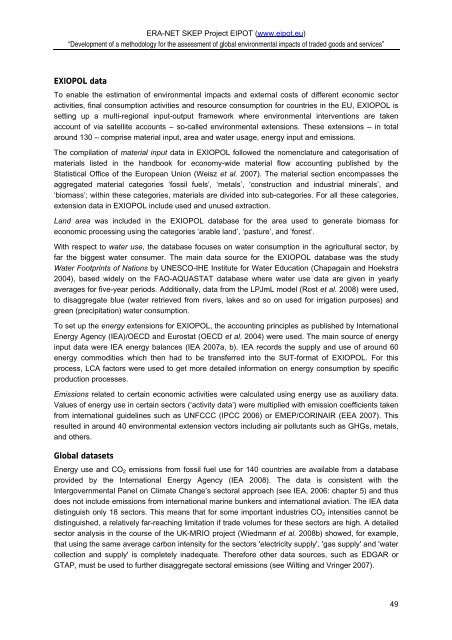EIPOT Final Project Report - Stockholm Environment Institute
EIPOT Final Project Report - Stockholm Environment Institute
EIPOT Final Project Report - Stockholm Environment Institute
You also want an ePaper? Increase the reach of your titles
YUMPU automatically turns print PDFs into web optimized ePapers that Google loves.
ERA-NET SKEP <strong>Project</strong> <strong>EIPOT</strong> (www.eipot.eu)<br />
“Development of a methodology for the assessment of global environmental impacts of traded goods and services”<br />
EXIOPOL data<br />
To enable the estimation of environmental impacts and external costs of different economic sector<br />
activities, final consumption activities and resource consumption for countries in the EU, EXIOPOL is<br />
setting up a multi-regional input-output framework where environmental interventions are taken<br />
account of via satellite accounts – so-called environmental extensions. These extensions – in total<br />
around 130 – comprise material input, area and water usage, energy input and emissions.<br />
The compilation of material input data in EXIOPOL followed the nomenclature and categorisation of<br />
materials listed in the handbook for economy-wide material flow accounting published by the<br />
Statistical Office of the European Union (Weisz et al. 2007). The material section encompasses the<br />
aggregated material categories ‘fossil fuels’, ‘metals’, ‘construction and industrial minerals’, and<br />
‘biomass’; within these categories, materials are divided into sub-categories. For all these categories,<br />
extension data in EXIOPOL include used and unused extraction.<br />
Land area was included in the EXIOPOL database for the area used to generate biomass for<br />
economic processing using the categories ‘arable land’, ‘pasture’, and ‘forest’.<br />
With respect to water use, the database focuses on water consumption in the agricultural sector, by<br />
far the biggest water consumer. The main data source for the EXIOPOL database was the study<br />
Water Footprints of Nations by UNESCO-IHE <strong>Institute</strong> for Water Education (Chapagain and Hoekstra<br />
2004), based widely on the FAO-AQUASTAT database where water use data are given in yearly<br />
averages for five-year periods. Additionally, data from the LPJmL model (Rost et al. 2008) were used,<br />
to disaggregate blue (water retrieved from rivers, lakes and so on used for irrigation purposes) and<br />
green (precipitation) water consumption.<br />
To set up the energy extensions for EXIOPOL, the accounting principles as published by International<br />
Energy Agency (IEA)/OECD and Eurostat (OECD et al. 2004) were used. The main source of energy<br />
input data were IEA energy balances (IEA 2007a, b). IEA records the supply and use of around 60<br />
energy commodities which then had to be transferred into the SUT-format of EXIOPOL. For this<br />
process, LCA factors were used to get more detailed information on energy consumption by specific<br />
production processes.<br />
Emissions related to certain economic activities were calculated using energy use as auxiliary data.<br />
Values of energy use in certain sectors (‘activity data’) were multiplied with emission coefficients taken<br />
from international guidelines such as UNFCCC (IPCC 2006) or EMEP/CORINAIR (EEA 2007). This<br />
resulted in around 40 environmental extension vectors including air pollutants such as GHGs, metals,<br />
and others.<br />
Global datasets<br />
Energy use and CO 2 emissions from fossil fuel use for 140 countries are available from a database<br />
provided by the International Energy Agency (IEA 2008). The data is consistent with the<br />
Intergovernmental Panel on Climate Change’s sectoral approach (see IEA, 2006: chapter 5) and thus<br />
does not include emissions from international marine bunkers and international aviation. The IEA data<br />
distinguish only 18 sectors. This means that for some important industries CO 2 intensities cannot be<br />
distinguished, a relatively far-reaching limitation if trade volumes for these sectors are high. A detailed<br />
sector analysis in the course of the UK-MRIO project (Wiedmann et al. 2008b) showed, for example,<br />
that using the same average carbon intensity for the sectors 'electricity supply', 'gas supply' and 'water<br />
collection and supply' is completely inadequate. Therefore other data sources, such as EDGAR or<br />
GTAP, must be used to further disaggregate sectoral emissions (see Wilting and Vringer 2007).<br />
49
















